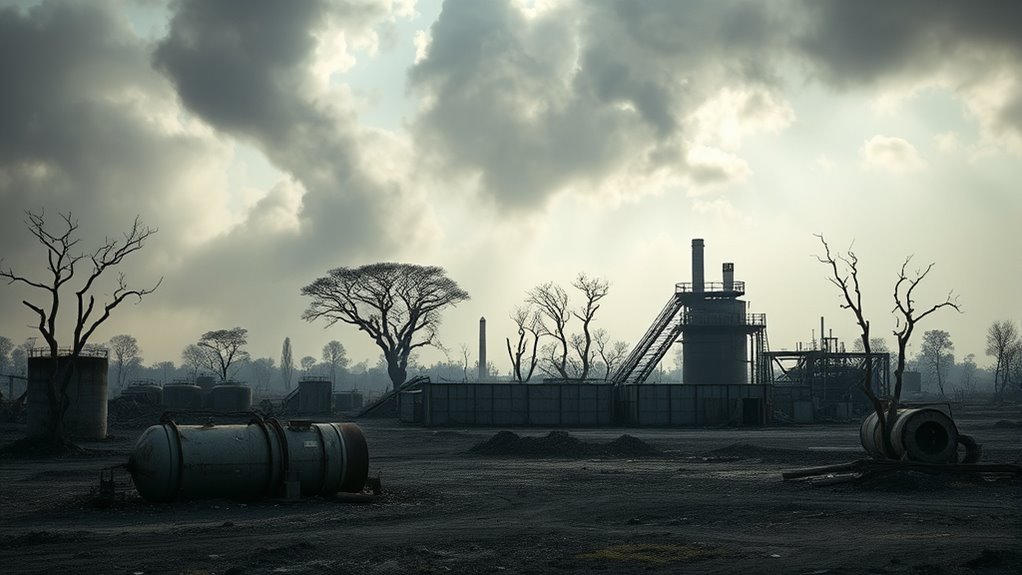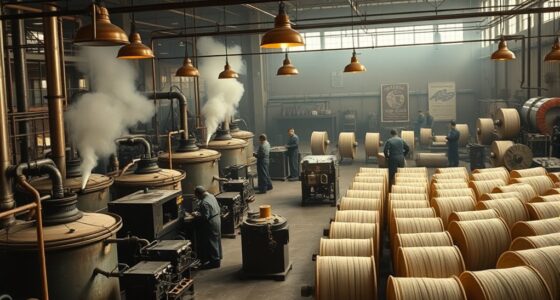The Bhopal disaster shows how neglecting process safety can lead to catastrophe. When safety protocols and maintenance are overlooked, a small incident can escalate into an irreversible tragedy. Proper containment, staff training, and a strong safety culture are essential to prevent such disasters. Cost-cutting measures shouldn’t compromise safety standards. If you want to understand how these failures happen and how to avoid them, stay with us to learn more about ensuring industrial safety.
Key Takeaways
- The disaster highlights the critical need for robust safety protocols and regular maintenance in industrial operations.
- Weak safety culture and inadequate risk assessment can lead to catastrophic chemical leaks.
- Proper containment systems and safety systems are essential to prevent toxic releases during emergencies.
- Staff training and proactive safety management are vital to minimize human error and response delays.
- Prioritizing safety over cost-cutting measures can prevent disasters and protect human lives and the environment.

Have you ever wondered what happens when industrial safety measures fail on a massive scale? The Bhopal disaster offers a stark and tragic answer. On the night of December 2, 1984, a chemical leak at the Union Carbide India Limited plant in Bhopal, India, transformed a routine industrial operation into a catastrophe that claimed thousands of lives. If you look at it closely, this disaster underscores the critical importance of robust industrial safety protocols and the devastating consequences when they break down. You see, a chemical release of this magnitude didn’t happen by accident; it resulted from a series of safety lapses, poor maintenance, and overlooked hazards that could have been prevented. It’s a stark reminder that when safety measures aren’t diligently implemented and monitored, the risks of chemical release skyrocket, putting countless lives in danger.
The Bhopal disaster shows what can happen when industrial safety fails on a massive scale.
In the lead-up to the disaster, the plant stored large quantities of methyl isocyanate (MIC), a highly toxic chemical. Despite warnings and known hazards, safety systems were not fully operational, and safety culture was weak. This negligence created a fragile environment where a minor fault could trigger disaster. When a runaway reaction occurred, it caused the release of a toxic cloud that spread over Bhopal’s densely populated neighborhoods. The chemical release was instantaneous and overwhelming, exposing thousands to deadly fumes. Many people died within hours, and thousands more suffered long-term health effects, including respiratory issues, blindness, and birth defects. The incident vividly illustrates how neglecting industrial safety can escalate into a catastrophe with far-reaching consequences.
Additionally, the incident highlights the importance of process safety and the need for continuous risk assessment to prevent such tragedies. You might think that such a disaster is a rare anomaly, but it’s a cautionary tale about the importance of rigorous safety standards. Proper industrial safety isn’t just about compliance; it’s about safeguarding human life and the environment. If safety protocols had been more thorough, including better containment systems, regular maintenance, and staff training, the chemical release could have been prevented or minimized. The tragedy shows what can happen when safety becomes an afterthought or when cost-cutting measures compromise safety systems. It’s a stark lesson that safety isn’t optional—it’s essential to prevent disaster.
Understanding the Bhopal disaster encourages you to prioritize safety in any industrial setting. You should question whether safety measures are fully implemented and if safety culture is embedded within the organization. Remember, when safety fails, the consequences aren’t just material—they’re human lives. The lessons from Bhopal emphasize that proactive safety management and a culture of vigilance are your best defenses against catastrophic chemical releases. It’s your responsibility to learn from this tragedy and ensure that safety remains at the forefront of industrial operations.
Frequently Asked Questions
What Immediate Safety Measures Could Have Prevented the Disaster?
To prevent the disaster, you should have strictly followed containment protocols to contain hazardous chemicals and prevent leaks. Conducting regular safety drills ensures everyone knows how to respond quickly in emergencies, reducing risks. Implementing layered safety measures, such as automatic shutdowns and proper maintenance, would also help. These immediate actions could markedly minimize hazards and prevent catastrophic incidents like Bhopal.
How Did Regulatory Failures Contribute to the Accident?
Regulatory failures played a vital role in the disaster by allowing lax oversight and weak safety enforcement at the plant. You might not have noticed, but insufficient inspections and poor adherence to safety standards meant hazards went unaddressed. Without strict regulatory oversight, the plant operators lacked proper guidance and accountability, increasing the risk of a catastrophic failure. Strengthening safety enforcement and ensuring rigorous oversight could have greatly prevented such a tragedy.
Were There Warning Signs Prior to the Disaster?
You would notice warning signs like chemical leaks and poor equipment maintenance before the disaster. These issues often signal unsafe conditions, but if ignored or unnoticed, they can escalate. Regular inspections and immediate repairs could have revealed these signs early, allowing you to take corrective actions. Recognizing such warning signs is essential to prevent accidents, especially in facilities handling hazardous chemicals, where neglect can lead to catastrophic consequences.
What Long-Term Health Effects Have Been Observed?
You might experience long-term health effects like chronic illnesses, including respiratory issues, eye problems, and neurological damage. Mental health struggles, such as anxiety and depression, are also common among those affected. These effects can persist years after the disaster, impacting your quality of life. It’s vital to seek ongoing medical care and mental health support to manage these lasting health consequences effectively.
How Has the Incident Influenced Global Process Safety Standards?
Imagine a delicate glass bridge, strengthened with steel cables—this symbolizes how global process safety standards have evolved. You see, the incident prompted tighter chemical safety regulations worldwide, emphasizing risk management and safety protocols. It led to stricter laws, international cooperation, and improved emergency responses, making industries more vigilant. As a result, you now benefit from safer workplaces and better protection against chemical hazards, ensuring such tragedy doesn’t happen again.
Conclusion
You see, the Bhopal disaster is a stark reminder that neglecting process safety is like building a house on shifting sands. When corners are cut, catastrophe lurks just beneath the surface, ready to erupt like a volcano. By learning from this tragedy, you hold the power to prevent future nightmares. Safety isn’t just a protocol; it’s the sturdy shield that keeps your operations from burning to ash in a single, preventable moment.









